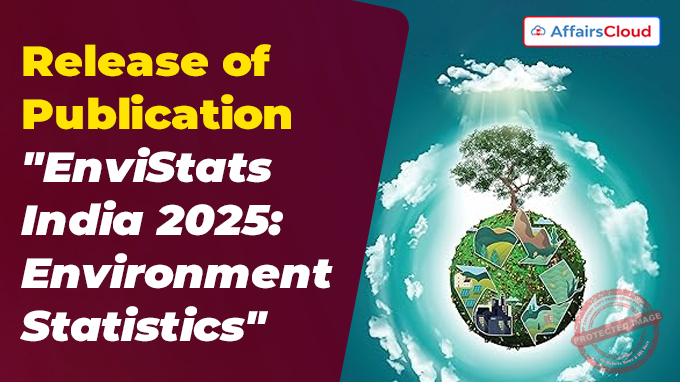 On 5 June 2025, the National Statistical Office (NSO), Ministry of Statistics and Programme Implementation (MoSPI), has released the 8th edition of the publication titled “EnviStats India 2025: Environment Statistics” during the ‘National Workshop on Using Alternate Data Sources and Frontier Technologies for Policy Making’ in New Delhi, Delhi.
On 5 June 2025, the National Statistical Office (NSO), Ministry of Statistics and Programme Implementation (MoSPI), has released the 8th edition of the publication titled “EnviStats India 2025: Environment Statistics” during the ‘National Workshop on Using Alternate Data Sources and Frontier Technologies for Policy Making’ in New Delhi, Delhi.
- The report provides a detailed overview of India’s environmental status, highlighting key trends, sectoral challenges, and progress made across multiple domains.
About the EnviStats India 2025: Environment Statistics:
i.It is a key resource for policymakers, researchers, and stakeholders, offering a comprehensive overview of the country’s environmental landscape.
ii.Since 2018, the NSO has been publishing “EnviStats India” in alignment with the Framework for the Development of Environment Statistics (FDES) 2013, a United Nation-recommended statistical framework for environmental data.
- The data presented in the publication are compiled based on the data sourced from various Ministries, Departments and Organisations of Government of India(GoI).
iii.The data presented in this report are organized into six components, such as Environmental Conditions and Quality; Environmental Resources and their Use; Residuals; Extreme Events and Disasters; Human Settlements and Environmental Health; and Environmental Protection, Management, and Engagement.
iv.For the first time, the report includes detailed information on how many people in India have access to electricity, transport, and sanitation. The report also features a specially prepared list of Ramsar Sites (important wetlands recognised globally), based on suggestions from experts.
Key Findings:
i.Thermal Power Generation has increased from 7,92,053 Gigawatt-hour (GWh) to 13,26,549 GWh and Electricity generation from Renewable Energy(RE) sources has increased from 65520 GWh to 2,25,835 GWh during 2013-14 to 2023-24.
ii.Inland fish production has increased from 61.36 lakh tonnes to 139.07 lakh tonnes during 2013-14 to 2023-24, indicating inland aquaculture and freshwater fisheries.
- With slower growth, Marine production has also increased from 34.43 lakh tonnes to 44.95 lakh tonnes during the same period.
iii.The annual mean temperature increased from 25.05°Celsius (°C) in 2001 to 25.74°C in 2024.
- Similarly, the annual minimum temperature rose from 19.32°C to 20.24°C and maximum temperature rose from 30.78°C to 31.25°C during the same period.
iv.The annual rainfall data from 2001 to 2024 highlights significant year-to-year variability influenced by monsoon patterns. Despite the variability, the data does not indicate any long-term upward or downward trend in total annual rainfall.
v.Globally, there are 2,47,605 marine faunal species, while India accounts for 20,613.
- India has 9,436 freshwater species, 5,023 species in the Indian Mangrove System, 3,383 species in the Estuarine Ecosystem, and 22,404 species in its Soil Ecosystem.
- Globally, there are 1,673,627 faunal species, of which 104,561 species are found in India.
vi.The Environmental Sustainability Sector shows the highest expenditure share as Rs.2433.24 crores in 2021-22.
- The Conservation of Natural Resource Sector shows an upward trend, and the Agro-Forestry Sector exhibits the lowest expenditure among the three sectors such as Agro-Forestry, Conservation of Natural Resources, and Environment Sustainability.
About Ministry of Statistics and Programme Implementation (MoSPI):
Minister of State (MoS) (Independent Charge, IC) – Rao Inderjit Singh (Constituency – Gurgaon, Haryana)




